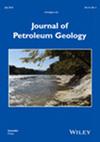伊朗南部dezful凹陷构造样式:中新世gachsaran组拆离与zagros锋面断裂体系的综合影响
IF 1.7
4区 地球科学
Q3 GEOSCIENCES, MULTIDISCIPLINARY
引用次数: 3
摘要
伊朗西南部扎格罗斯褶皱和逆冲带的结构去耦受显生宙地层柱中存在的中间脱离层(如富含蒸发岩的层段)的控制。分离层位的有效性在整个扎格罗斯各不相同,并控制着褶皱的样式,从而控制着构造圈闭的形成。在本文中,利用现场测绘、地震解释和井数据研究了位于南德兹富尔湾(扎格罗斯中部)西北-东南走向扎格罗斯前缘断层系统表面迹线两侧的六个大型背斜的复杂结构样式。在其中一些背斜处,Gachsaran组中新世下中期蒸发岩将褶皱上覆序列与包括Asmari组储层在内的有效下伏层段解耦。断层地表暴露东北部的背斜比西南部的背斜缩短了四倍。与区域值相比,这种局部缩短在某些情况下导致了复杂的不对称褶皱,以及Gachsaran组上下严重的结构解耦。然而,断层NE方向的其他背斜也经历了类似的缩短,但其中Gachsaran组的厚度减少,含盐量较低,在该组上下表现出和谐的褶皱样式。因此,Gachsaran分离的效率在整个研究区域各不相同,似乎主要受地层总厚度、其中富盐层段的净厚度以及整个Zagros正向断层系统的结构缩短量的控制。这些观测结果可能与Zagros和其他褶皱和逆冲带中的类似结构域有关,在这些褶皱和逆推带中,中等分离层位和区域规模的断层共同控制了褶皱和构造圈闭的构造。本文章由计算机程序翻译,如有差异,请以英文原文为准。
STRUCTURAL STYLE IN THE SOUTH DEZFUL EMBAYMENT, SW IRAN: COMBINED INFLUENCE OF THE ZAGROS FRONTAL FAULT SYSTEM AND THE DETACHMENT IN THE MIOCENE GACHSARAN FORMATION
Structural decoupling in the Zagros fold‐and‐thrust belt, SW Iran, is controlled by the presence of intermediate detachment horizons within the Phanerozoic stratigraphic column such as intervals rich in evaporites. The effectiveness of the detachment horizons varies across the Zagros, and controls the style of folding and therefore the formation of structural traps. In this paper, field mapping, seismic interpretation and well data is used to investigate the complex structural style at six large‐scale anticlines located on either side of the surface trace of the NW‐SE trending Zagros Frontal Fault system in the South Dezful Embayment (Central Zagros). At some of these anticlines, lower – middle Miocene evaporites in the Gachsaran Formation decouple the folded overlying succession from the competent, underlying interval which includes the Asmari Formation reservoir. Anticlines to the northeast of the surface exposure of the fault have undergone four times more shortening than anticlines to the southwest. This localized shortening compared to regional values has resulted in some cases in complex asymmetric folding, and in severe structural decoupling above and below the Gachsaran Formation. However, other anticlines to the NE of the fault which underwent a similar amount of shortening, but in which the thickness of the Gachsaran Formation is reduced and the salt content is lower, show a harmonic style of folding above and below the formation. Thus, the efficiency of the Gachsaran detachment varies throughout the study area and appears to be controlled mainly by the total thickness of the formation, the net thickness of salt‐rich intervals within it, and the amount of structural shortening across the Zagros Frontal Fault system. These observations could be relevant to similar structural domains both in the Zagros and in other fold‐and‐thrust belts where intermediate detachment horizons and regional‐scale faults have together controlled the configuration of folds and structural traps.
求助全文
通过发布文献求助,成功后即可免费获取论文全文。
去求助
来源期刊

Journal of Petroleum Geology
地学-地球科学综合
CiteScore
3.40
自引率
11.10%
发文量
22
审稿时长
6 months
期刊介绍:
Journal of Petroleum Geology is a quarterly journal devoted to the geology of oil and natural gas. Editorial preference is given to original papers on oilfield regions of the world outside North America and on topics of general application in petroleum exploration and development operations, including geochemical and geophysical studies, basin modelling and reservoir evaluation.
 求助内容:
求助内容: 应助结果提醒方式:
应助结果提醒方式:


